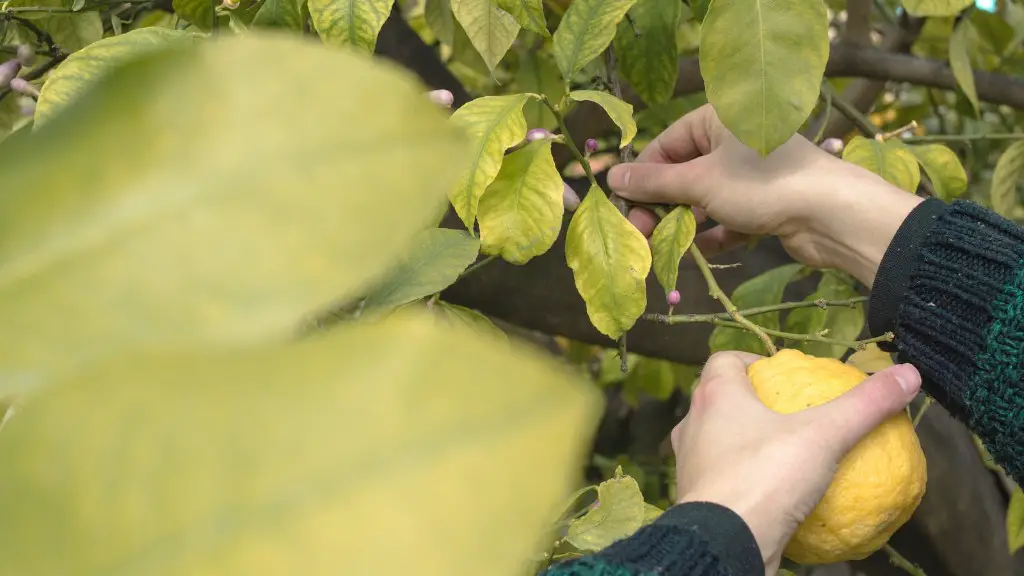In order to plant a lemon tree in a container, you will need acontainer that is at least 15 gallons, a high-quality potting mix,well-draining soil, and a lemon tree. Once you have all of these materials, you will need to prepare the container by making sure it has drainage holes in the bottom. Next, you will need to fill the container with the potting mix and water it well. After the container has been filled and watered, you will need to plant the lemon tree. When planting the tree, make sure to plant it at the same depth it was in the container it came in. Once the tree has been planted, you will need to water it well and fertilize it.
The best way to plant a lemon tree in a container is to choose a pot that is at least 20 inches wide and 20 inches deep. Fill the pot with well-draining potting soil, and make sure the pot has drainage holes. Place the lemon tree in the pot, and backfill with soil. Water the tree well, and place the pot in a sunny location.
Do lemon trees grow well in pots?
If you experience cooler weather during the fall and winter months, growing a potted lemon tree indoors is a great way to sustain the plant all year long. Since these trees are self-pollinating, only one is needed to produce fruit. Potted lemon trees do best in bright, indirect sunlight and should be watered when the top inch of soil is dry. Be sure to provide proper drainage for your tree, as lemons are susceptible to root rot. With a little care, your indoor lemon tree will provide you with fresh lemons all year round!
A new citrus tree will grow just fine in an 8-inch diameter container to start. Two to three year old trees will need a 10 to 12 inch diameter container. Eventually, you’ll need a 16 to 20 gallon container or one-half whiskey barrel-sized container for long term growth.
What is the best soil for a potted lemon tree
The lemon tree is a very versatile tree and can adapt to almost any type of soil excluding those of heavy clay. The ideal soil for this tree is a rich and well-drained sandy loam. Drained loam or sandy loam is the soil typically used for gardening because it produces more nutrients and moisture that can help the tree to grow vigorously.
Lemon trees require full sun for optimal growth, so choose a spot in your yard that gets at least 6-8 hours of direct sunlight each day. When planting, be sure to dig a hole that is twice the size of the tree’s root ball and mix in some compost or other organic matter to help the tree get established. Water regularly, especially during the hot summer months, and fertilize monthly with a citrus fertilizer. With proper care, your lemon tree will thrive and produce an abundance of juicy lemons for years to come!
Should you change the soil in a potted lemon tree?
A lemon tree will generally need to be repotted every three to four years. At this juncture, you have two options. You can transplant the tree into a larger container or lift it out, prune the roots, and repot it in the same container with fresh soil.
Watering your Meyer Lemon Tree is important to keeping it healthy and happy. Check the soil once a week and water it if it feels dry to the touch. Slowly pour water into the pot and count to 20, or wait until you see water running out of the bottom of the pot. Generally, Meyer Lemon Trees need water every one to two weeks.
How long do lemon trees last in pots?
Lemon trees are a type of citrus tree that typically live for 30 to 50 years. However, indoor potted lemon trees often have shorter lifespans than those planted in the ground outdoors. Under ideal conditions, lemon trees can grow to be over 100 years old.
If you’re thinking of growing lemon in pots, make sure the pot is big enough. This tree can grow up to 20 feet (6 m.) tall with a spread of 10 feet (3 m.), so choose a pot that’s at least 18 inches (46 cm.) in diameter.
It’s also important to choose a pot with drainage holes. Lemon trees are sensitive to overwatering, so make sure the pot has good drainage so the roots don’t sit in water.
Finally, choose a potting mix that’s designed for citrus trees. This mix will be slightly acidic and will hold moisture well.
How long does it take for a lemon tree to bear fruit
The regular lemon tree takes up to six years to bear fruit when grown outdoors in warm climates. The lemon tree can grow up to 20 feet tall in these climates.
There are a few key things to remember when it comes to growing succulents in succulent potting mix:
The mix should be well-draining.
The mix should be light and airy.
The mix should contain a variety of ingredients like sphagnum peat moss, composted forest products, sand, and perlite.
Can I use Miracle Grow potting soil for lemon tree?
If you’re growing citrus in pots indoors in NYC, it’s best to steer clear of Miracle Grow soil, as it’s too heavy for these delicate plants. Stick with a lighter soil mix or make your own using perlite, vermiculite, and compost.
It is important to feed citrus trees in containers so that they can get the nutrients they need to grow. There are two options for doing this: using a slow-release fertilizer once a year in early spring or a liquid fertilizer every other week. If you can’t find a fertilizer specifically labeled for citrus, you can use one with twice as much nitrogen as phosphorous, such as 12-6-6.
What month do you plant lemon trees
Lemon trees can be planted in either late winter or early spring, but the best results will come from planting during the preferred season. If your climate conditions are warm, you can plant potted trees year-round. Be sure to provide plenty of sunlight and water to your tree, as these are essential for healthy growth. With proper care, your lemon tree will thrive and provide you with an abundance of delicious fruit for many years to come.
1. Lesions on leaves: this is a problem caused by citrus canker, and can be treated by removing the affected leaves and applying a fungicide.
2. Black moldy spots: this is a problem caused by sooty mold, and can be treated by removing the affected leaves and applying an insecticide.
3. Fuzzy gray mold and brown spots: this is a problem caused by botrytis blight, and can be treated by removing the affected leaves and applying a fungicide.
4. Tan spots with dark outlines: this is a problem caused by anthracnose, and can be treated by removing the affected leaves and applying a fungicide.
5. Brown scabs: this is a problem caused by lemon scab, and can be treated by removing the affected leaves and applying a fungicide.
How deep should a lemon tree be planted?
To ensure your citrus tree has the best chance for a long and healthy life, be sure to dig a hole that’s about 15 times the width of the root ball and just as deep. This will give the roots plenty of room to spread out and establish themselves. Happy planting!
Soil compaction and poor drainage can be a real problem for plants, especially ones that require well-drained soil, like cactus, palm, citrus and succulents. That’s why Miracle-Gro has formulated a fast-draining potting mix that’s enriched with their own plant food. This mix contains forest products, sand and perlite to help improve drainage and prevent compaction, so your plants can thrive.
What is the best soil mix for container citrus
The soil should be light and fluffy to allow the roots to easily spread, and it should drain well to prevent the roots from becoming waterlogged. A potting mix with a combination of compost, coconut coir or peat moss, and vermiculite or perlite is the best type of soil for container grown citrus.
Citrus trees are a bit more delicate than other houseplants and require a bit more care during the winter months. Lowering the room temperature to around 58-68 degrees will help the tree to go semi-dormant, which is crucial for its health. Additionally, providing supplemental lighting and rotating the plant regularly will help it to thrive. Fertilizing monthly and improving air circulation are also important. Finally, be sure to water the tree properly and watch for pests.
Warp Up
Most citrus trees do well in containers, and lemon trees are no exception. For best results, choose a dwarf or patio lemon tree, as these are typically smaller and more compact than other types of lemon trees. When selecting a pot, make sure it is at least 18 inches wide and has drainage holes.
Fill the pot with a high-quality potting mix or all-purpose garden soil, and plant the tree at the same depth it was growing in the nursery pot. Water the tree thoroughly, and then place it in a sunny spot.
During the growing season, water the lemon tree whenever the soil feels dry to the touch. Fertilize monthly with a citrus fertilizer, following the manufacturer’s instructions. In winter, water only when the soil is dry, and do not fertilize.
When the tree is producing fruit, you may need to thin the lemon crop to prevent the fruit from getting too big. Simply remove some of the lemons from the tree, leaving about 6 inches between each fruit.
When growing lemon trees in containers, choose a pot that is at least 18 inches wide and has good drainage. Be sure to use a potting mix specifically for citrus trees. Water your lemon tree regularly, but do not over water. fertilize your tree every two to four weeks with a citrus fertilizer. Place your tree in a sunny spot, and enjoy your fresh lemons!




